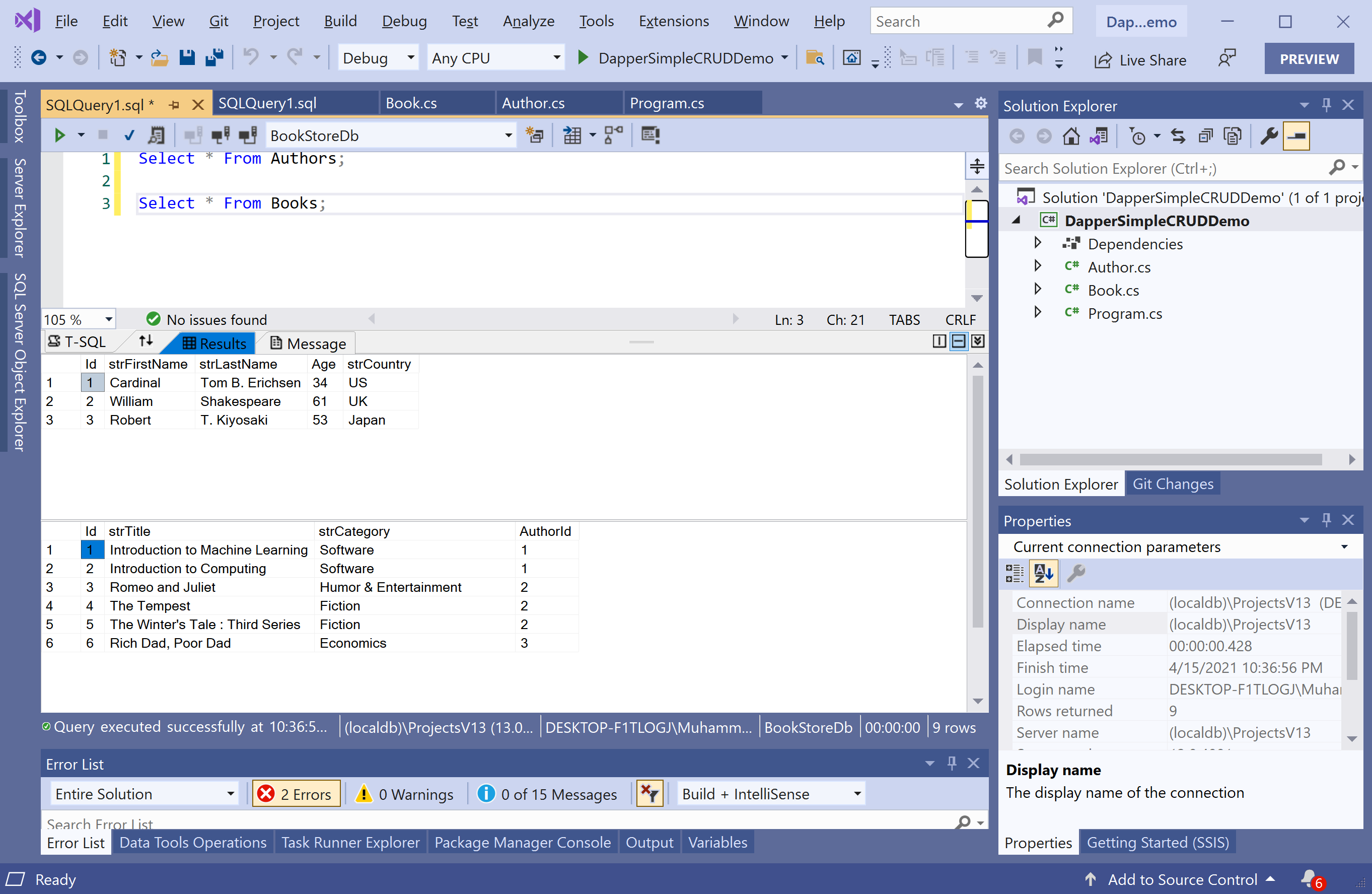Dapper FluentMap Manual Mapping
The Dapper.FluentMap library provides the EntityMap<TEntity> class which allows you to map property names to the column names in the database manually. As you know that we have two tables in the database that contains the following data.

Now let's create two classes called Author and Book. Here is the implementation of the Author class.
using System;
using System.Collections.Generic;
using System.Linq;
using System.Text;
using System.Threading.Tasks;
namespace DapperFluentMapDemo
{
public class Author
{
public int Id { get; set; }
public string FirstName { get; set; }
public string LastName { get; set; }
public string FullName
{
get
{
return FirstName + " " + LastName;
}
}
public int Age { get; set; }
public string Country { get; set; }
public List<Book> Books { get; set; }
}
}
The following is the implementation of the Book class.
using System;
using System.Collections.Generic;
using System.ComponentModel.DataAnnotations.Schema;
using System.Linq;
using System.Text;
using System.Threading.Tasks;
namespace DapperFluentMapDemo
{
public class Book
{
public int Id { get; set; }
public string Title { get; set; }
public string Category { get; set; }
public int AuthorId { get; set; }
}
}
If you look at the columns in the database and the respective properties in the model classes. You will see that few properties are not matching with columns such as strFirstName, strLastName and strCountry in the Authors table and strTitle and strCategory in the Books table.
Now to map all the columns in the Authors table with the corresponding properties in the Author class, let's create a class called AuthorMap and derived it from the EntityMap<Author> class.
using Dapper.FluentMap.Mapping;
using System;
using System.Collections.Generic;
using System.Linq;
using System.Text;
using System.Threading.Tasks;
namespace DapperFluentMapDemo
{
public class AuthorMap : EntityMap<Author>
{
public AuthorMap()
{
Map(a => a.FirstName)
.ToColumn("strFirstName");
Map(a => a.LastName)
.ToColumn("strLastName");
Map(a => a.Country)
.ToColumn("strCountry");
Map(a => a.FullName)
.Ignore();
}
}
}
When you derive a class from EntityMap<TEntity>, the constructor gives you access to the Map method, which allows you to specify to which database column should be mapped to a certain property of TEntity.
Similarly, create another class and defined mappings for the Book class, as shown below.
using System;
using System.Collections.Generic;
using System.Linq;
using System.Text;
using System.Threading.Tasks;
using Dapper.FluentMap.Mapping;
namespace DapperFluentMapDemo
{
public class BookMap : EntityMap<Book>
{
public BookMap()
{
Map(b => b.Title)
.ToColumn("strTitle");
Map(b => b.Category)
.ToColumn("strCategory");
}
}
}
We have defined all the required mappings, now we need to initialize our mappings at the start of the application.
FluentMapper.Initialize(config =>
{
config.AddMap(new AuthorMap());
config.AddMap(new BookMap());
});
We can now perform any database operations using Dapper as shown below.
static void Main(string[] args)
{
FluentMapper.Initialize(config =>
{
config.AddMap(new AuthorMap());
config.AddMap(new BookMap());
});
Author author = GetAuthorAndTheirBooks(2);
Console.WriteLine("{0} ({1})", author.FullName, author.Country);
foreach (var book in author.Books)
{
Console.WriteLine("\t Title: {0} \t Category: {1}", book.Title, book.Category);
}
}
private static Author GetAuthorAndTheirBooks(int id)
{
string sql =
"SELECT * FROM Authors WHERE Id = @Id;" +
"SELECT * FROM Books WHERE AuthorId = @Id;";
using (IDbConnection db = new SqlConnection(ConnectionString))
{
using (var results = db.QueryMultiple(sql, new { Id = id }))
{
var author = results.Read<Author>().SingleOrDefault();
var books = results.Read<Book>().ToList();
if (author != null && books != null)
{
author.Books = books;
}
return author;
}
}
}
Let's execute the above code, and you will see the following output.
William Shakespeare (UK)
Title: Romeo and Juliet Category: Humor & Entertainment
Title: The Tempest Category: Fiction
Title: The Winter's Tale : Third Series Category: Fiction
